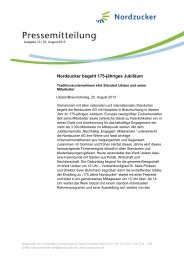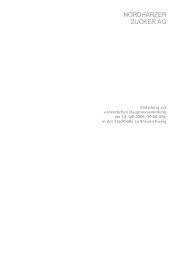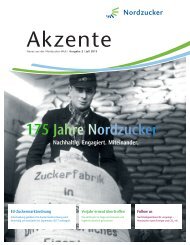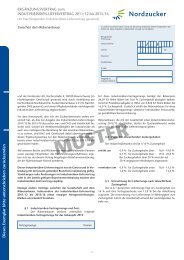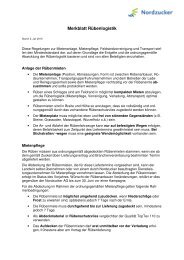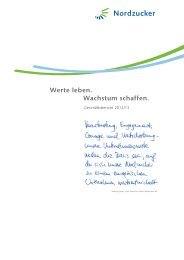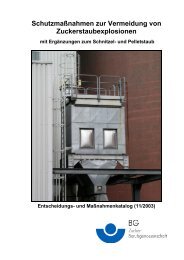downloads - Nordzucker AG
downloads - Nordzucker AG
downloads - Nordzucker AG
Create successful ePaper yourself
Turn your PDF publications into a flip-book with our unique Google optimized e-Paper software.
Talking to …<br />
People at <strong>Nordzucker</strong>:<br />
Kazimierz Kuśmierek has been working<br />
at the Chełmża plant for 38 years.<br />
IN BRIEF<br />
24 The bright world of <strong>Nordzucker</strong><br />
PEOPLE AT NORDZUCKER<br />
26 Kazimierz Kuśmierek: Technical Manager<br />
Sugar House and Service Center in Chełmża<br />
CLICKED ON<br />
27 Looking online<br />
RECIPE<br />
28 Rote Grütze compote in mini sponge rolls<br />
26<br />
Prof. em. Dr phil.<br />
Hans Jürgen Teuteberg<br />
was Professor of Contemporary<br />
Economic and Social History<br />
and Director of the History<br />
Department at the University<br />
of Münster.<br />
In 1747, the Berlin-born chemist Andreas Sigismund<br />
Marggraf discovered that sugar from three types of beet<br />
is chemically identical to sugar from sugar cane. His pupil<br />
Franz Carl Achard continued this research and established<br />
the first sugar beet factory in Silesia in 1802. However, it<br />
would be decades before sugar production using sugar<br />
beet would catch on. Three questions for Professor<br />
Teuteberg on the history of sugar.<br />
In 1838, a sugar factory was opened in Klein Wanzleben.<br />
How did the sugar industry develop during the following<br />
decades?<br />
“Between 1840 and 1870, when the German Empire was<br />
founded, the number of German sugar beet factories<br />
increased more than fivefold, from 54 to 304. At the same<br />
time, the amount of beet processed rose from 26,080<br />
tonnes to three million tonnes. At the end of the 1850s,<br />
beet sugar production had already reached such a level<br />
that it exceeded domestic demand and began to be<br />
exported.”<br />
What helped to drive this development?<br />
“In addition to the fiscal environment, successful sugar<br />
beet breeding and advancing industrialisation were driving<br />
forces. In the middle of the 19th century, the Frenchman<br />
Louis de Vilmorin discovered that the sugar content of<br />
beets can be increased by means of systematic breeding.<br />
At the same time, it was possible to significantly cut<br />
production costs in the sugar factories by using steampowered<br />
machines and conveyor belts.”<br />
What did this mean for sugar consumption?<br />
“Until the middle of the 19th century, most people didn’t<br />
consume sugar because they simply could not afford to pay<br />
the high prices. Sugar is a typical product of industrialisation<br />
and, together with the potato, represents the biggest<br />
change in our eating habits since the late Middle Ages.”<br />
Akzente July 2013 5







